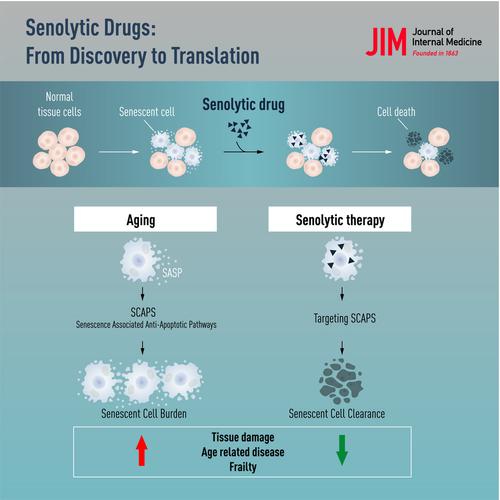当前位置:
X-MOL 学术
›
J. Intern. Med.
›
论文详情
Our official English website, www.x-mol.net, welcomes your
feedback! (Note: you will need to create a separate account there.)
Senolytic drugs: from discovery to translation.
Journal of Internal Medicine ( IF 9.0 ) Pub Date : 2020-07-19 , DOI: 10.1111/joim.13141
J L Kirkland 1 , T Tchkonia 1
Journal of Internal Medicine ( IF 9.0 ) Pub Date : 2020-07-19 , DOI: 10.1111/joim.13141
J L Kirkland 1 , T Tchkonia 1
Affiliation

|
Senolytics are a class of drugs that selectively clear senescent cells (SC). The first senolytic drugs Dasatinib, Quercetin, Fisetin and Navitoclax were discovered using a hypothesis‐driven approach. SC accumulate with ageing and at causal sites of multiple chronic disorders, including diseases accounting for the bulk of morbidity, mortality and health expenditures. The most deleterious SC are resistant to apoptosis and have up‐regulation of anti‐apoptotic pathways which defend SC against their own inflammatory senescence‐associated secretory phenotype (SASP), allowing them to survive, despite killing neighbouring cells. Senolytics transiently disable these SCAPs, causing apoptosis of those SC with a tissue‐destructive SASP. Because SC take weeks to reaccumulate, senolytics can be administered intermittently – a ‘hit‐and‐run’ approach. In preclinical models, senolytics delay, prevent or alleviate frailty, cancers and cardiovascular, neuropsychiatric, liver, kidney, musculoskeletal, lung, eye, haematological, metabolic and skin disorders as well as complications of organ transplantation, radiation and cancer treatment. As anticipated for agents targeting the fundamental ageing mechanisms that are ‘root cause’ contributors to multiple disorders, potential uses of senolytics are protean, potentially alleviating over 40 conditions in preclinical studies, opening a new route for treating age‐related dysfunction and diseases. Early pilot trials of senolytics suggest they decrease senescent cells, reduce inflammation and alleviate frailty in humans. Clinical trials for diabetes, idiopathic pulmonary fibrosis, Alzheimer’s disease, COVID‐19, osteoarthritis, osteoporosis, eye diseases and bone marrow transplant and childhood cancer survivors are underway or beginning. Until such studies are done, it is too early for senolytics to be used outside of clinical trials.
中文翻译:

衰老药物:从发现到转化。
Senolytics 是一类选择性清除衰老细胞 (SC) 的药物。第一种抗衰老药物达沙替尼、槲皮素、非瑟酮和 Navitoclax 是使用假设驱动的方法发现的。SC随着年龄的增长和多种慢性疾病的发病部位积累,包括占发病率、死亡率和健康支出大部分的疾病。最有害的 SC 对细胞凋亡具有抗性,并且具有上调的抗凋亡途径,这些途径可以保护 SC 免受自身炎症性衰老相关分泌表型 (SASP) 的影响,从而使它们能够存活,尽管会杀死邻近的细胞。Senolytics 会暂时禁用这些 SCAP,导致那些具有组织破坏性 SASP 的 SC 细胞凋亡。因为 SC 需要数周时间才能重新积累,所以可以间歇性地使用抗衰老药物——一种“打了就跑”的方法。在临床前模型中,senolytics 可延迟、预防或减轻虚弱、癌症和心血管、神经精神、肝脏、肾脏、肌肉骨骼、肺、眼、血液、代谢和皮肤疾病以及器官移植、放射和癌症治疗的并发症。正如预期的那样,针对作为多种疾病“根本原因”贡献者的基本衰老机制的药物,senolytics 的潜在用途是千变万化的,可能在临床前研究中缓解 40 多种疾病,为治疗与年龄相关的功能障碍和疾病开辟了一条新途径。senolytics 的早期试验表明,它们可以减少衰老细胞,减少炎症并缓解人类的虚弱。糖尿病、特发性肺纤维化、阿尔茨海默病、COVID-19、骨关节炎、骨质疏松症、眼病和骨髓移植以及儿童癌症幸存者正在进行或开始。在完成此类研究之前,将 senolytics 用于临床试验之外还为时过早。
更新日期:2020-07-19
中文翻译:

衰老药物:从发现到转化。
Senolytics 是一类选择性清除衰老细胞 (SC) 的药物。第一种抗衰老药物达沙替尼、槲皮素、非瑟酮和 Navitoclax 是使用假设驱动的方法发现的。SC随着年龄的增长和多种慢性疾病的发病部位积累,包括占发病率、死亡率和健康支出大部分的疾病。最有害的 SC 对细胞凋亡具有抗性,并且具有上调的抗凋亡途径,这些途径可以保护 SC 免受自身炎症性衰老相关分泌表型 (SASP) 的影响,从而使它们能够存活,尽管会杀死邻近的细胞。Senolytics 会暂时禁用这些 SCAP,导致那些具有组织破坏性 SASP 的 SC 细胞凋亡。因为 SC 需要数周时间才能重新积累,所以可以间歇性地使用抗衰老药物——一种“打了就跑”的方法。在临床前模型中,senolytics 可延迟、预防或减轻虚弱、癌症和心血管、神经精神、肝脏、肾脏、肌肉骨骼、肺、眼、血液、代谢和皮肤疾病以及器官移植、放射和癌症治疗的并发症。正如预期的那样,针对作为多种疾病“根本原因”贡献者的基本衰老机制的药物,senolytics 的潜在用途是千变万化的,可能在临床前研究中缓解 40 多种疾病,为治疗与年龄相关的功能障碍和疾病开辟了一条新途径。senolytics 的早期试验表明,它们可以减少衰老细胞,减少炎症并缓解人类的虚弱。糖尿病、特发性肺纤维化、阿尔茨海默病、COVID-19、骨关节炎、骨质疏松症、眼病和骨髓移植以及儿童癌症幸存者正在进行或开始。在完成此类研究之前,将 senolytics 用于临床试验之外还为时过早。

































 京公网安备 11010802027423号
京公网安备 11010802027423号